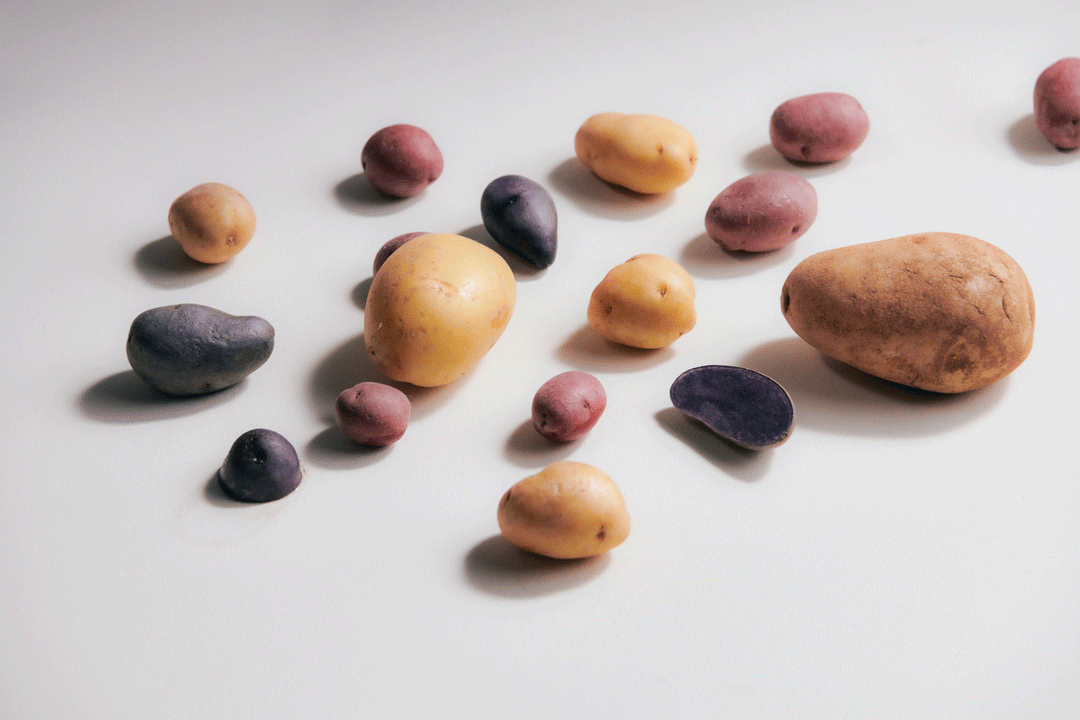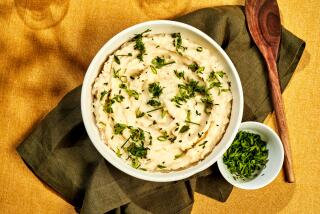This Spud’s for You
When a friend of mine needs cheering up, she makes a big bowl of mashed potatoes just for herself. Most people appreciate the soothing quality of mashed potatoes, but not everyone realizes how easy they are to prepare.
With homey mashed potatoes now holding a place of honor on fine restaurant menus and accompanying luxurious entrees such as scallops, lobster and squab, some chefs make them sound like a big production. In fact, nothing could be easier. You simply cook the potatoes until tender, drain them, mash them while they are still hot and beat in milk and a little butter.
Recipes from celebrity chefs, whether French or American, often require so much butter that few people would want to make them at home. Yet the chef I studied with in Paris made fabulous, silky-smooth potato puree with only a modest pat of butter and a generous amount of milk. Often I use low-fat milk and only about a teaspoon of butter per person, and the potatoes are still very good.
Not all mashed potatoes are soft, creamy and delicate. There is another basic type, which is hearty and robust. The potatoes are mashed coarsely and moistened with only a small amount of liquid, which might be potato cooking liquid or chicken stock instead of milk. Butter is not necessarily added.
In the Perigord region of central France, these potatoes might be enhanced with chicken roasting juices and flavored with chopped shallots. Spicy Calabrian Mashed Potatoes from Southern Italy get their zest from peppers, both hot and sweet, and garlic. Onions sauteed in oil flavor an Israeli mashed potato version. In India the potatoes might be spiced with chiles.
At La Varenne Cooking School in Paris, we mashed potatoes restaurant-style, by pushing them through a large drum sieve. This took some effort, not to mention the labor of cleaning the sieve afterward. Pressing the potatoes through a ricer or a food mill is easier and produces a light, fluffy puree. I don’t like to use a food processor--it tends to make the potatoes gluey.
Actually, I find the easiest tool to use for small quantities (eight servings or less) is the old-fashioned American potato masher, because you can mash the potatoes right in the saucepan. If you don’t have a masher, you can crush the drained potatoes in the pot with a wooden spoon, the way our chef’s wife did at home.
You can steam or bake the potatoes, but cutting them into pieces and cooking them in water is the quickest way. I peel the potatoes before I mash them, but to save time, you can skip this step.
The starch of mature potatoes is needed for fluffy-textured mashed potatoes. Russets or Idaho potatoes are favorites, but you can also use large red- or white-skinned potatoes.
Pureeing potatoes in the French manner makes them light, smooth, soft and rich-tasting. Chefs usually heat the milk in a separate saucepan but you can skip this step if you add the milk gradually to the hot puree over low heat.
CREAMY MASHED POTATOES
2 pounds russet potatoes or white boiling potatoes, scrubbed
Salt
White pepper
2 to 4 tablespoons butter
Freshly grated nutmeg
About 3/4 cup milk
Cut each potato into 2 or 3 pieces. Place potatoes in non-aluminum saucepan. Add water to just cover and dash of salt. Cover and bring to boil. Simmer over medium heat about 20 minutes or until potatoes are very tender. Drain thoroughly and peel. Mash with potato masher in saucepan (or puree potatoes in food mill or potato ricer and return to saucepan).
Add butter and few tablespoons milk to potatoes. Season to taste with salt, white pepper and nutmeg. Heat over low heat, stirring vigorously with wooden spoon, until mixture is light and smooth. Add remaining milk gradually, still stirring over low heat. (Potatoes should be soft but not soupy. If puree is too stiff, beat in milk by tablespoons.) Adjust salt, pepper and nutmeg to taste. Serve hot. Makes 6 servings.
Note: Mashed potatoes can be prepared 30 minutes ahead. To keep hot, pour few tablespoons cold milk over top without stirring in to prevent skin from forming. Set saucepan of potatoes in pan of hot water over low heat. Before serving, stir in milk.
Each serving contains about:
184 calories; 158 mg sodium; 14 mg cholesterol; 5 grams fat; 32 grams carbohydrates; 4 grams protein; .5 gram fiber; 24% calories from fat.
Serve these spicy potatoes with chicken, turkey, sausages or grilled fish. Or serve them on their own, accompanied by a green salad and by yogurt, cottage cheese or a warm hard-cooked egg.
CALABRIAN MASHED POTATOES WITH PEPPERS
1 pound large potatoes, scrubbed
Salt
Freshly ground pepper
1 sweet red or green pepper, or 1/2 of each
2 tablespoons olive oil
1 dried hot red chile, halved crosswise
1 clove garlic, minced
1 tablespoon chopped parsley, optional
2 to 3 tablespoons grated pecorino or Parmesan cheese, plus more for serving separately, optional
Cut each potato into 2 or 3 pieces. Place in non-aluminum saucepan with water to just cover and dash of salt. Cover, bring to boil and simmer over medium heat about 20 minutes or until potatoes are very tender.
Cut pepper into strips and halve crosswise. Heat olive oil in skillet, add hot red chile and sweet pepper and saute 7 minutes over medium heat, stirring frequently. Reduce heat and saute 2 minutes or until tender. Add garlic and saute over low heat 15 to 20 seconds. Transfer mixture, including oil, to bowl. Discard hot pepper pieces.
Drain potatoes thoroughly, reserving liquid. Peel potatoes, if desired. Mash in saucepan, leaving some whole pieces. Beat in 2 or 3 tablespoons potato liquid. Reserve few pepper strips for garnish and stir remaining pepper-garlic mixture into potatoes. Add parsley, cheese and freshly ground pepper. Adjust seasonings to taste. Garnish with pepper strips and serve with more cheese, if desired. Makes 2 or 3 servings.
Each serving contains about:
371 calories; 329 mg sodium; 7 mg cholesterol; 17 grams fat; 49 grams carbohydrates; 9 grams protein; 1 gram fiber; 40% calories from fat.


